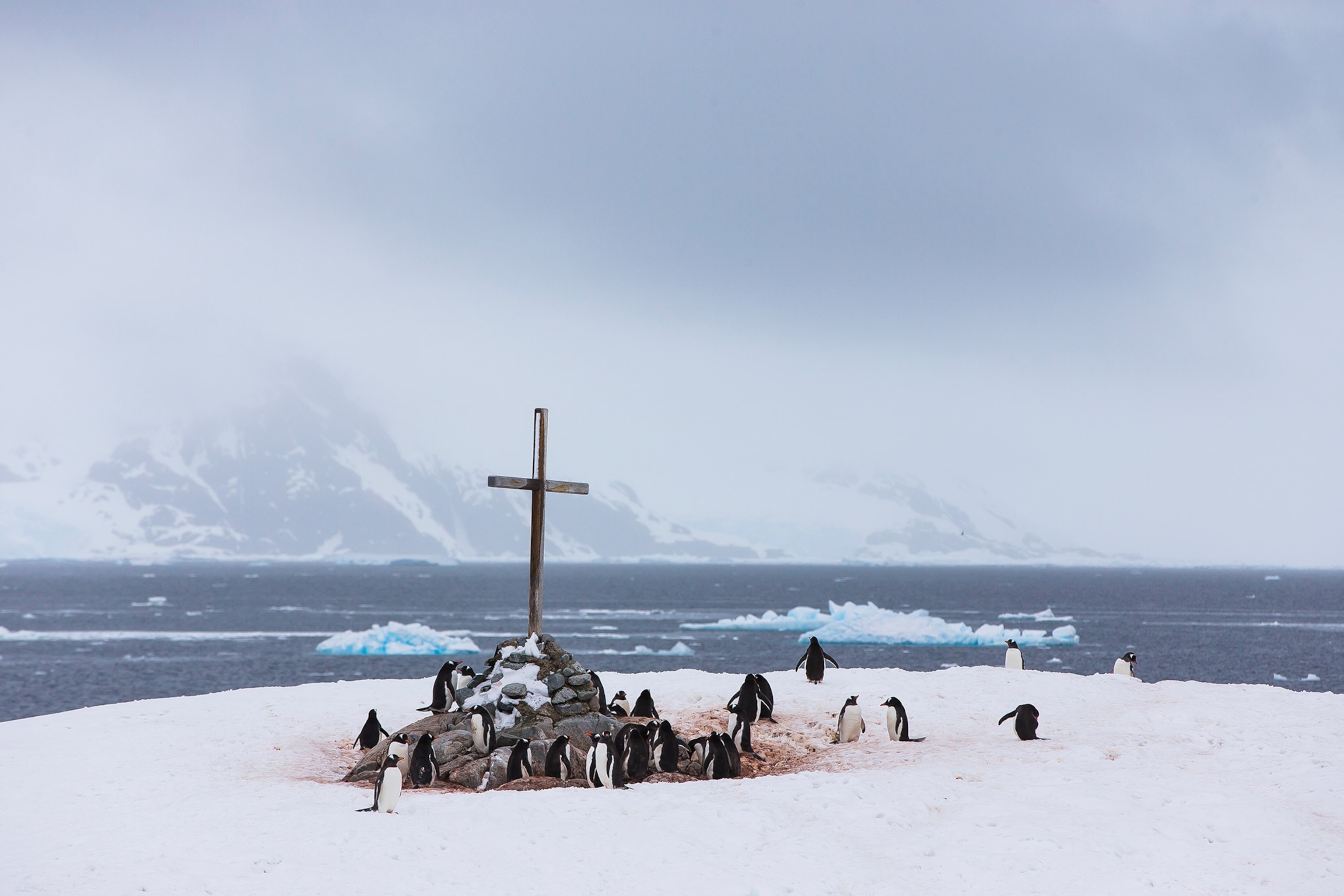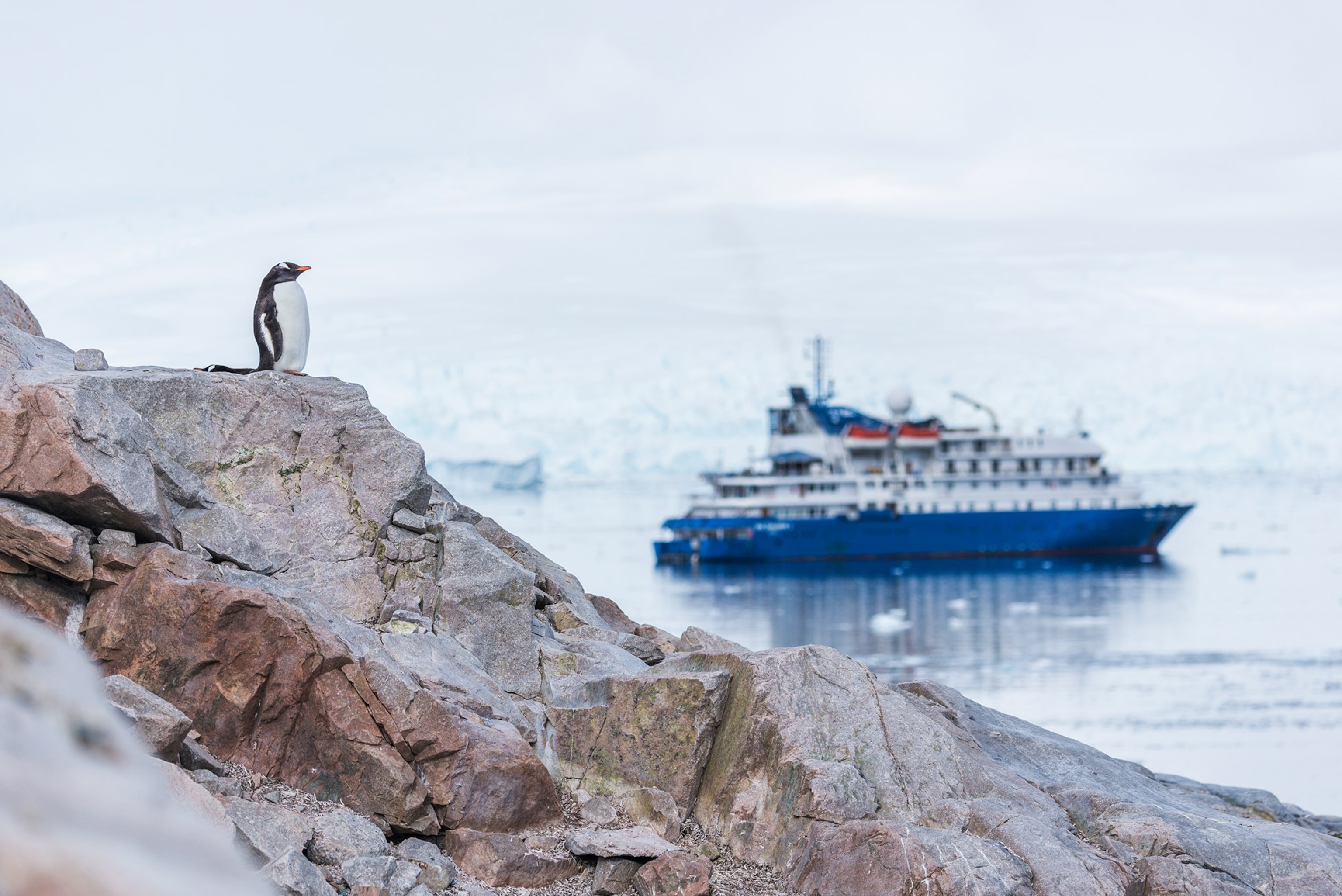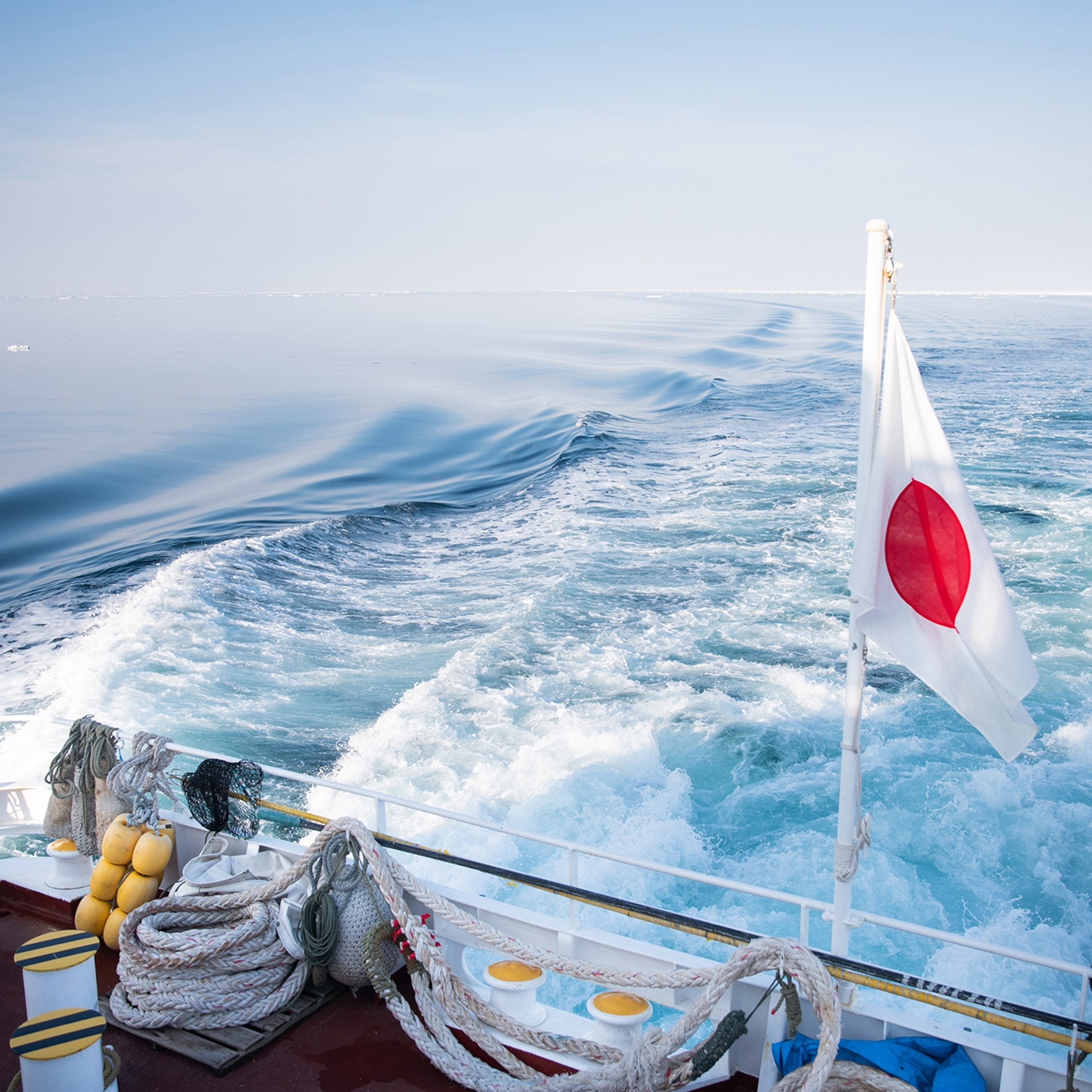
It’s summer in Antarctica. Here’s how to explore responsibly.
Small-scale scientific expeditions help balance tourism and preservation in this frozen frontier at the ends of the Earth.
It’s extremely rare, as a tourist, to gain access to a pristine region that’s been set aside primarily for science and conservation. It’s equally rare to experience a place where wild birds and animals, instead of fleeing, surround you. The islands and coasts of the Southern Ocean, in Antarctica, comprise one such place; their only rival for Edenic natural drama is the Galápagos Islands.
While most of the 10,000 or so people who reside in Antarctica during the austral summer are climatologists, glaciologists, ornithologists, and ecologists, a steady trickle of ecotourists visit, braving lengthy flights and stormy seas. Between November and March in a normal year, around 40,000 tourists cruise around this remarkable region.
Although that might seem like a lot of people for an ecologically delicate destination, the International Association of Antarctic Tour Operators (IAATO) has strict conservation protocols to minimize damage. Modest-yet-comfy expedition ships like the one I’m taking, carrying no more than 200 passengers, make it easy for green-thinking individuals to make their visit as eco-friendly as possible.

These ships are sturdy little icebreakers with a below-average carbon footprint. Some have streamlined hulls and hybrid engines; others do away with the luxury cruise ship amenities, so they burn less fuel.
But what really sets these expedition ships apart are their knowledgeable guides, who offer lectures and excursions that teach guests everything from seal biology to survival skills. Aboard one of these ships, we get a fleeting taste of what it might be like to be a polar scientist, naturalist, or explorer.
The ship I’ve chosen is classed as “small,” meaning we can steer into narrow inlets and are permitted to make shore landings. In preparation, we inspect our outdoor gear fastidiously.
“Come on everyone, show us your Velcro,” say the expedition guides, checking our fastenings and seams for seeds, insects, mud, or sand and scrubbing every inch with a vacuum cleaner.
They school us in environmental respect, which includes keeping our distance from wildlife and leaving no trace. “No tissues, no crumbs, no messages in the snow!” Soon, they’re unloading the Zodiacs (rigid inflatable boats), ready to bounce us across the ice-strewn sea, right into the thick of things.
Sixty-five degrees south
Neko Harbor fringes Andvord Bay, a pristine Antarctic fjord with an elegant, elongated shape, rather like the outline of Italy. Toward the start of Antarctica’s notoriously brutal whaling era, just over a century ago, cargo ships here served as floating factories. Today, after a hard-won reversal of fortunes, the lake-smooth, iceberg-scattered waters of Andvord Bay are a picture of peace.
As I watch from the beach, a humpback whale and her calf make a leisurely appearance, muddling the mirror image of the mountains beyond and prompting a flurry of camera action among the Zodiac passengers who happen to be extremely close. After the water settles, a small flock of Wilson’s storm petrels dances lightly across the surface, plucking krill from the water.
(Read why New York City is a whale-watching hotspot.)
The snow-laden slopes that rise behind the beach are striped with penguin paths that climb steeply to nest sites above. Steady streams of gentoo penguins, like hikers at a busy alpine resort, plod doggedly up and down. I crunch my way around the harbor to a slope that overlooks a mighty glacier. As I pause to admire the cliffs of ice, there’s a thunderous boom as a section collapses, sending a mini tsunami of ripples radiating across the bay.
The deliberate exploitation of wildlife may be over, but Antarctica now faces a different threat. According to climate scientists, calving events—the poster phenomena of climate change in the polar regions—are becoming more common.

The Antarctic Peninsula is warming approximately six times faster than the global average, and the ice shelves surrounding it are thinning. Although the region appears untouched by human hands, climate effects are far reaching, and Antarctica is very fragile.
(What do we lose when icebergs break off Antarctica’s most endangered glacier?)
Across turbulent seas
My voyage began in the tourist-friendly port of Ushuaia in southern Patagonia, close to South America’s pointed toe. On a late-afternoon cruise through the Beagle Channel, a rite of passage begins.
For two days, our ship bucks and rolls its way across the infamous Drake Passage, an ocean crossing so stormy that every object that isn’t permanently fixed takes on a life of its own. My cabin, incongruously furnished with open shelves, ends up looking like a poltergeist has done its worst.
Weather worries are an understandable preoccupation for Antarctic tourists. We’ve all seen photos of gnarly polar adventurers with snowy eyelashes, icicled noses, and frostbitten extremities. In 2020, however, the region experienced its highest ever recorded temperatures—exceeding 64°F at the peninsula’s northern tip—for the second year since 2015.
In reality, I find it easy to stay comfortable, dressing from top to toe in breathable layers and protecting myself against sun, wind, and sea. We quickly get used to the routine of descending to the ship’s mudroom to kit ourselves out in waterproofs, thick-soled rubber boots and compact lifejackets for the next adventure.
(Read the untold story of the boldest polar expedition of modern times.)
On our earliest forays, we watch the sunrise gild the glaciers edging the Neumayer and Lemaire Channels, skim across calm waters to our first penguin colonies at Damoy Point, and see leopard seals lounging on pads of ice, their faces fixed in sinister, predatory smiles.
This late in the summer, the leopards are well fed: plenty of fledgling Adélie and chinstrap penguins have already flopped into the water, risking the seals’ deadly jaws. The gentoos, which breed later, will be next; for now, the downy chicks remain on land, pestering their parents for food the moment they lurch back from their foraging trips.

Hungry young gentoos scurry around Port Lockroy’s historic huts and Royal Mail post office, while their elders inspect our dry bags and defend themselves against opportunistic sheathbills.
We continue on to Pléneau Bay, where we admire icebergs that seem to glow from within, and to Trinity Island, where we tiptoe through a sculpture park of curvaceous ice and velvety seals. Later, on Petermann Island, we discover that Antarctic snow isn’t always white; as the climate warms, algae fertilized by penguin guano can tint it olive green or rose pink.
Neko Harbor and its near neighbor, the aptly named Paradise Bay, offer us another exciting first: a chance to set foot on the Antarctic mainland, pondering the dizzying notion that if we were to continue another 25 degrees south, climbing around 9,000 feet, we’d reach the South Pole.
In the wake of a great explorer
Since Antarctica’s weather and sea conditions can be challenging, landings—whether on the islands or the mainland—are never guaranteed. On top of that, IAATO’s rules state that only one ship can visit each landing site at a time, with no more than 100 people allowed on shore at any given moment. As well as minimizing disturbance, this maximizes adventure. Each time we land, it’s almost as if ours is the first party to have ever arrived.
People have been landing on the Southern Ocean’s shores since James Cook first crossed the Antarctic Circle in 1773. For several decades, however, they didn’t progress beyond the islands: it was only in early 1821 that adventurers set foot on the mainland for the first time.
Focused on hunting seals for profit rather than making history, these pioneers kept quiet about their movements; the locations of the best landing spots were a trade secret. But curiosity grew, and within 100 years, some of the world’s most celebrated explorers had made their mark on the continent. By the end of the 20th century, the shift from ruthless exploitation of Antarctica’s natural resources to science, conservation, and ecotourism was more or less complete.
As we round the tip of the peninsula, the weather flares up, forcing the captain to change course. “This is where things get really interesting,” says assistant expedition leader Christophe Gouraud. We take it in turns to cram onto the bridge, watching silently as the officers navigate a tricky route past monumental icebergs, their cliffs crazed with cracks.
Venturing into locations that expedition ships rarely visit, we explore the Antarctic Sound and dip the ship’s toes in the Weddell Sea. We spend two hours cruising past the immense A-68A, the rogue tabular iceberg that, until recently, seemed to be heading for South Georgia, posing a serious threat to its delicate ecosystems.
On Elephant Island (named for the mighty seals that once lolled on its rocky shore), chinstrap penguins dodge the spray. It’s this scrap of beach where the crew of Ernest Shackleton’s Endurance expedition were stranded for 105 days in 1916. It took the explorer another 16 grueling days to sail from here to South Georgia to seek help, a crossing we manage in just over two.
(Here’s how polar explorers survived months of isolation.)
“Everyone looks forward to South Georgia—even the guys from the engine room who you never normally see,” says expedition ornithologist Ab Steenvoorden, who scans the skies for albatrosses on our approach. “They save up their time off and go out on their own Zodiac trips. It’s an incredible island, and the only way you can get here is by sea.”
Disembarking at Peggotty Bluff, where Shackleton, already exhausted, began his epic island crossing, I’m amused to discover that South Georgia’s wild animals are even more fearless than Antarctica’s. Young fur seals, relentlessly curious and prone to biting, galumph toward us. We fling out our arms to make ourselves look big, giving them pause, then pick our way through the tussock grass to a distant cove, ruled by a true giant: an elephant seal as long as a skip.
The morning we arrive in St. Andrew’s Bay, I wake early and head out on deck, binoculars in hand. I notice that the river of speckles on the shore is shifting. They’re king penguins—an estimated 300,000 adults, plus chicks. Within an hour or two, I’ll be standing among these stately birds as they preen, posture, and call. A fellow voyager says it perfectly: “This is one of those places that you really have to experience first-hand, with your own eyes, ears, nose, heart, and soul.”
How to go
Getting there & around: The main departure points for Antarctic cruises are Ushuaia in Argentina and Punta Arenas in Chile. From Buenos Aires and Santiago, you can connect to Ushuaia with Aerolíneas Argentinas, or Punta Arenas with LATAM Airlines.
Antarctic expedition ships usually take two days to cruise the Beagle Channel and Drake Passage and spend four or five days around the South Shetlands and Antarctic Peninsula before their two-day return leg. Longer itineraries, including South Georgia and the Falkland Islands, last two to three weeks.
When to go: Antarctic expedition cruises operate between November and March. In high season (December and January), daytime temperatures around the Antarctic Peninsula average a relatively mild 34°F, the days are long and penguins can be seen tending their chicks. In later months, the penguins begin disappearing out to sea, but as a consolation, whale sightings increase. South Georgia is colder, with temperatures rarely rising above zero and dipping to about 26°F by March.
More than two dozen cruise lines offer departures to Antarctica, including National Geographic Expeditions and Adventures by Disney. The Walt Disney Company is the majority owner of National Geographic Partners.
A version of this story first published in the May 2021 issue of National Geographic Traveller (UK).







